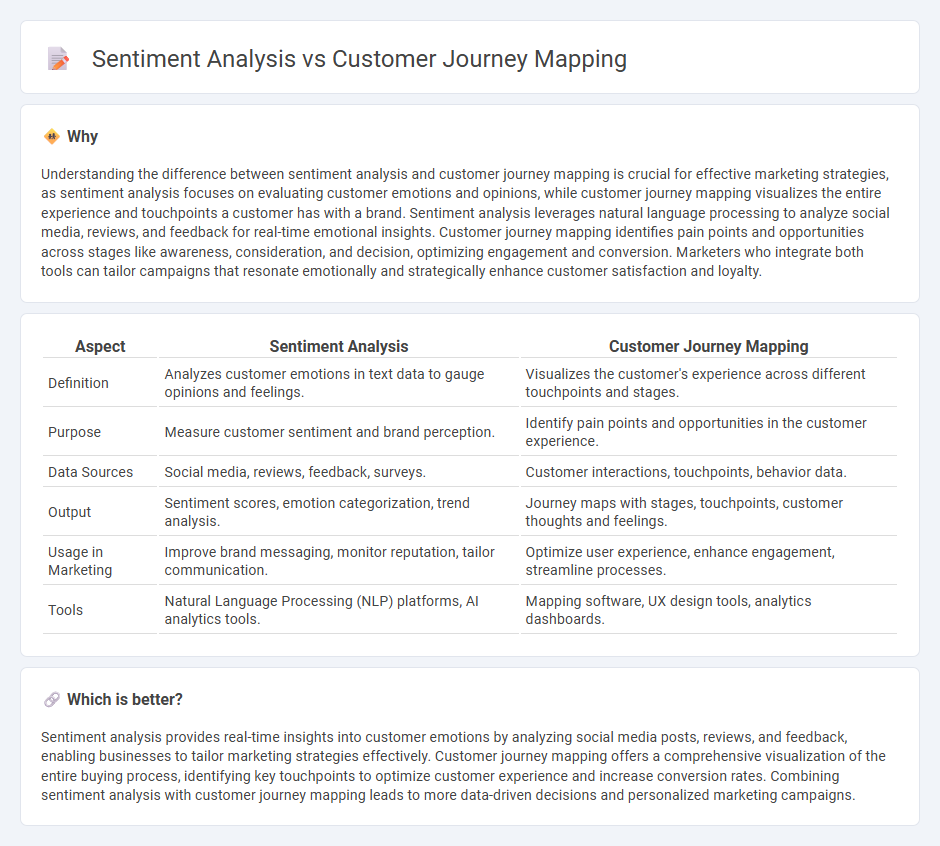
Sentiment analysis leverages natural language processing to gauge customer emotions from social media, reviews, and feedback, enabling brands to understand public perception in real-time. Customer journey mapping visualizes the entire experience from first contact to purchase, highlighting pain points and opportunities for engagement across multiple touchpoints. Explore the distinct benefits of these marketing strategies to enhance customer insights and drive business growth.
Why it is important
Understanding the difference between sentiment analysis and customer journey mapping is crucial for effective marketing strategies, as sentiment analysis focuses on evaluating customer emotions and opinions, while customer journey mapping visualizes the entire experience and touchpoints a customer has with a brand. Sentiment analysis leverages natural language processing to analyze social media, reviews, and feedback for real-time emotional insights. Customer journey mapping identifies pain points and opportunities across stages like awareness, consideration, and decision, optimizing engagement and conversion. Marketers who integrate both tools can tailor campaigns that resonate emotionally and strategically enhance customer satisfaction and loyalty.
Comparison Table
| Aspect | Sentiment Analysis | Customer Journey Mapping |
|---|---|---|
| Definition | Analyzes customer emotions in text data to gauge opinions and feelings. | Visualizes the customer's experience across different touchpoints and stages. |
| Purpose | Measure customer sentiment and brand perception. | Identify pain points and opportunities in the customer experience. |
| Data Sources | Social media, reviews, feedback, surveys. | Customer interactions, touchpoints, behavior data. |
| Output | Sentiment scores, emotion categorization, trend analysis. | Journey maps with stages, touchpoints, customer thoughts and feelings. |
| Usage in Marketing | Improve brand messaging, monitor reputation, tailor communication. | Optimize user experience, enhance engagement, streamline processes. |
| Tools | Natural Language Processing (NLP) platforms, AI analytics tools. | Mapping software, UX design tools, analytics dashboards. |
Which is better?
Sentiment analysis provides real-time insights into customer emotions by analyzing social media posts, reviews, and feedback, enabling businesses to tailor marketing strategies effectively. Customer journey mapping offers a comprehensive visualization of the entire buying process, identifying key touchpoints to optimize customer experience and increase conversion rates. Combining sentiment analysis with customer journey mapping leads to more data-driven decisions and personalized marketing campaigns.
Connection
Sentiment analysis enhances customer journey mapping by providing real-time insights into customer emotions at each touchpoint, allowing marketers to tailor experiences based on positive or negative feedback. Integrating sentiment data helps identify pain points and moments of delight, improving personalization and customer satisfaction. This connection enables more effective marketing strategies by aligning emotional responses with behavior patterns throughout the customer lifecycle.
Key Terms
**Customer Journey Mapping:**
Customer Journey Mapping visually represents the customer's experience across all touchpoints, highlighting pain points and opportunities for improvement to enhance overall satisfaction. It enables businesses to track customer interactions from awareness to purchase and post-purchase phases, fostering targeted strategies for engagement and loyalty. Explore detailed methods for optimizing customer experience through advanced journey mapping techniques.
Touchpoints
Customer journey mapping identifies and visualizes key touchpoints customers interact with throughout their experience, providing insight into behavior and decision stages. Sentiment analysis evaluates emotional responses and opinions expressed at these touchpoints, revealing customer satisfaction and pain points in real time. Explore how combining both approaches enhances customer experience and drives strategic improvements.
Personas
Customer journey mapping visualizes the entire experience a persona undergoes while interacting with a product or service, highlighting touchpoints and pain points. Sentiment analysis evaluates customer emotions and opinions from feedback, reviews, and social media, offering insight into personas' feelings at various stages. Explore how leveraging these methods together can deepen your understanding of customer personas and improve engagement strategies.
Source and External Links
The customer journey map and why it's important - A customer journey map is a visual representation of customer interactions with a company, outlining steps at every stage to predict behavior, anticipate needs, and improve responses by identifying touchpoints and customer emotions.
What is a Customer Journey Map? - IBM - It defines customer journey mapping as visualizing every customer experience with a brand through personas, key journey stages, touchpoints, emotions, pain points, and validation with real customers to ensure accuracy.
Customer Journey Maps: How to Create Really Good Ones ... - Customer journey maps capture the complex, often non-linear customer experience across multiple channels and touchpoints, helping businesses understand customers' interactions and identify friction points for improvement.
 dowidth.com
dowidth.com